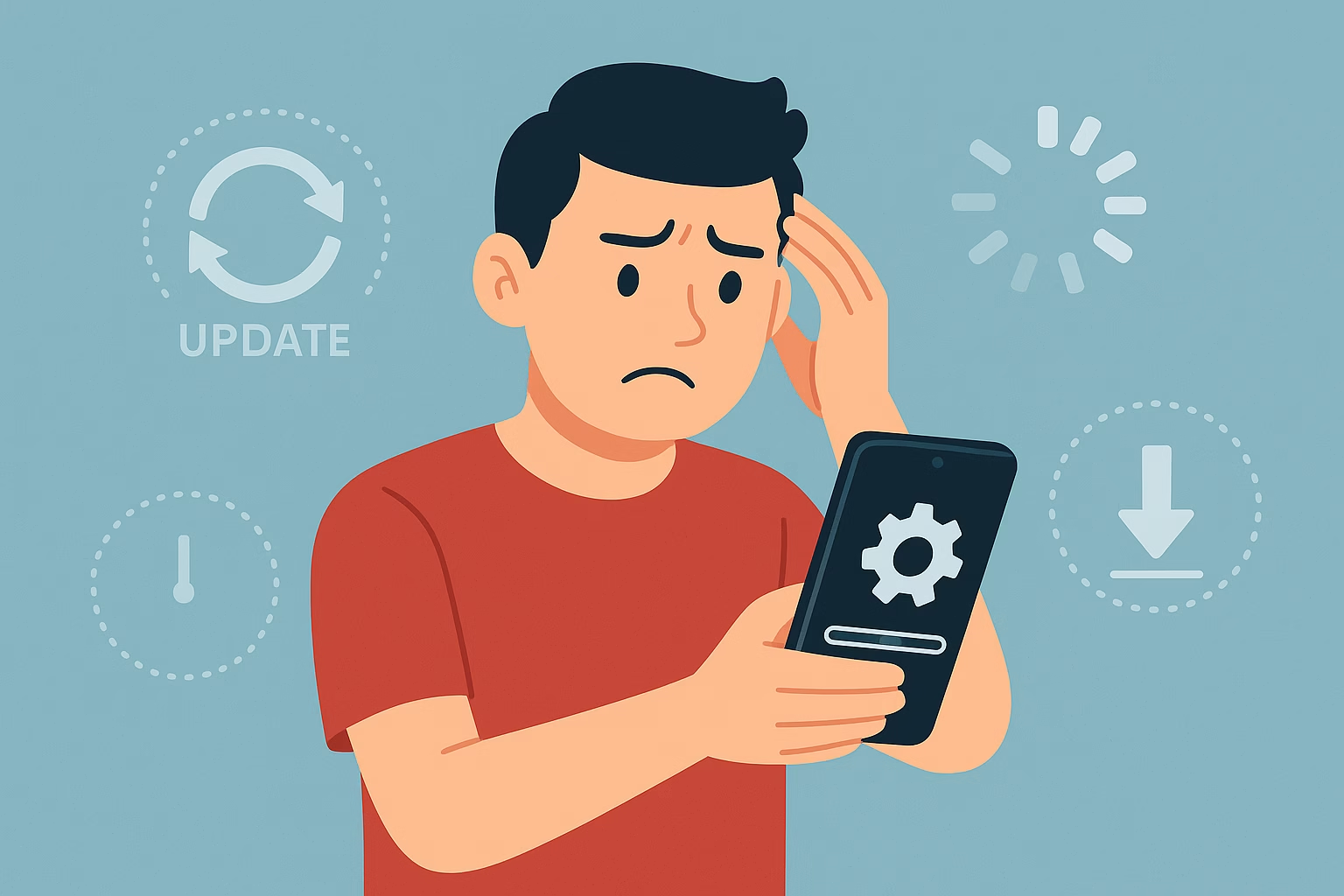Introduction: Smartphone slow down after updates
You waited patiently for that new software update. It promised better security, new features, and improved performance. But now, your phone feels sluggish. Apps take longer to load, scrolling stutters, and multitasking is a chore. If you’ve ever asked, “Why does my smartphone slow down after updates?”, you’re not alone.

This problem affects millions of users—Android and iPhone alike. And the reasons go far beyond just “your phone is old.” This article breaks down the real causes of smartphone slow down after updates and shows you exactly what to do to fix it.
Table of Contents
1. What Really Happens During a Software Update?
A software update is not just a visual refresh. Behind the scenes, it’s a major overhaul:
- System-level changes to how memory, CPU, and battery are managed
- Security patches that close vulnerabilities
- New features that may require more hardware power
- App framework updates that force your existing apps to adapt
All of this runs on the same processor and RAM you had before the update. So naturally, performance can take a hit—especially on older devices.
2. Why Smartphone Slow Down After Updates
Let’s break down the most common reasons:
a. Background Reindexing
After a major update, your phone reindexes data—photos, files, apps, and even contacts. This can take up to 48 hours, during which lag is normal.
b. App Incompatibility
Some apps aren’t updated in time to match the new OS. These outdated apps can cause crashes, memory leaks, and system lags.
c. More Features = More Load
New features, especially AI-based ones like live transcriptions or dynamic refresh rate, eat into your CPU and RAM even when you don’t use them.
d. Poor Battery Calibration
Updates reset battery behavior tracking. Your phone may underperform until it recalibrates your battery usage.
e. Thermal Throttling
Newer updates might push your phone harder, leading to overheating. Your phone automatically slows down to protect itself.
3. How to Check If the Update Is the Cause
Ask yourself:
- Was the slowdown immediately after the update?
- Are all apps affected or just a few?
- Is the phone heating up more often?
You can also:
- Check settings → battery → background usage
- Install diagnostic apps like AccuBattery (Android) or use Analytics Data (iPhone) to monitor app impact.
4. Android vs iPhone: Different Causes, Same Frustration
Android Users
- Heavily affected by OEM bloatware, especially on phones from Xiaomi, Vivo, and Samsung.
- Custom skins like One UI or MIUI often add features that demand more resources.
iPhone Users
- Apple optimizes updates for newer models, and older ones get slower as a result.
- After iOS 11, Apple admitted to throttling performance on older iPhones to preserve battery health—sparking the infamous “batterygate” scandal.
Key Point: Whether you use Android or iPhone, post-update slowdown is real—but fixable.
Internet Buffering Issue – Why Your Internet Is Fast but Videos Still Buffer
5. What You Can Do Immediately
If your phone has slowed down right after a software update, try these steps first:
✅ Give It 48 Hours
Let background indexing complete. Keep the phone charged and avoid heavy use.
✅ Restart the Phone
Simple, but effective. A reboot clears cache and temporary CPU load.
✅ Update Your Apps
Open the Play Store or App Store and update everything. Outdated apps are often the real culprits.
✅ Clear Cache (Especially for Android)
Go to Settings → Storage → Cached data and clear it.
Or boot into Recovery Mode and clear the system cache.

6. Long-Term Fixes to Speed Up Your Phone
Once the initial period is over, and the phone is still slow:
🔧 Disable Unused Features
- Turn off live wallpapers, motion effects, and background sync for unused apps.
- On iPhone: Settings → Accessibility → Reduce Motion
🔧 Free Up Storage
Keep at least 10–15% of storage free for the OS to function efficiently.
🔧 Check Battery Health
- Android: Use AccuBattery or OEM battery diagnostics
- iPhone: Settings → Battery → Battery Health & Charging
If battery health is under 80%, performance will be throttled.
🔧 Turn Off Animations (Android)
Go to Developer Options → Window animation scale → 0.5x or off
7. When You Should (and Shouldn’t) Roll Back an Update
🔄 Rollback: Should You Do It?
Android: Possible, but risky. You’ll need to flash older firmware, which can void the warranty or brick your phone.
iPhone: Apple stops signing old iOS versions quickly. Downgrading is nearly impossible unless you saved SHSH blobs.
✅ Rollback only if:
- Performance is unbearable
- You’re tech-savvy or have professional help
- You’ve backed up your data fully
8. Is It Done Deliberately? Planned Obsolescence Debate
This question keeps coming up: Are companies slowing down phones on purpose?
What We Know:
- Apple admitted to performance throttling—but claimed it was to protect battery life.
- No Android OEM has admitted to it, but users notice performance dips before new model launches.
Regardless of intent, the result is the same: old phones feel worse after updates.
But there’s hope. By controlling settings, offloading unused apps, and avoiding heavy multitasking, you can extend the usable life of your phone by years.
9. Tools and Settings to Monitor Performance
📱 Android:
- CPU-Z – Monitor processor load
- AccuBattery—Check power draw and battery health
- Disk Usage—Visualize storage clog
📱 iPhone:
- Analytics Data in Settings → Privacy → Analytics
- Battery Settings to monitor drainers
- Shortcuts app can automate clear-cache routines (to an extent)
10. Final Thoughts-Why Your Smartphone Slow Down After Updates
It’s frustrating when your smartphone slow down after update, especially when you expect better performance. But the good news is this slowdown isn’t permanent. Often, it’s temporary or fixable with the right steps.
Smartphone performance is a moving target—affected by updates, apps, battery health, and user habits. By understanding why things slow down and taking control of your settings, you can keep your phone running smoothly, even years after purchase.
✅ TL;DR
- Smartphone Slow Down After Updates, especially due to reindexing, app mismatches, and new feature loads.
- Give it 48 hours, update your apps, and clear cache.
- Check battery health—throttling kicks in when batteries degrade.
- Use built-in and third-party tools to monitor performance.
- Don’t jump to rollback unless you’re confident.
- Your phone isn’t dead—you just need to optimize it post-update.

You helped me a lot with this post. http://www.kayswell.com I love the subject and I hope you continue to write excellent articles like this.
Thank you for being of assistance to me. I really loved this article. http://www.kayswell.com
[…] RELATED: Why Your Smartphone Slow Down After Updates And What to Do […]
Your articles are extremely helpful to me. Please provide more information! http://www.kayswell.com
Please tell me more about this. May I ask you a question? http://www.kayswell.com
Thank you for writing this article. I appreciate the subject too. http://www.ifashionstyles.com
Please tell me more about this. May I ask you a question? http://www.kayswell.com